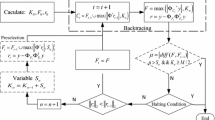Abstract
The null space pursuit (NSP) algorithm based on a fourth-order differential operator is a method of signal processing. The NSP algorithm uses an adaptive operator to separate a signal into additive subcomponents. Furthermore, it is possible to design different operators to fit different signal models. In this paper, we propose a new type of a differential operator. We theoretically derive the new differential operator and then test the proposed method using simulated signals.
Access this chapter
Tax calculation will be finalised at checkout
Purchases are for personal use only
Similar content being viewed by others
References
Rilling G, Flandrin P (2008) One or two frequencies? the empirical mode decomposition answers. IEEE Trans Signal Process 56(1):85–95
Wu Z, Huang NE (2004) A study of the characteristics of white noise using the empirical mode decomposition method. Proceedings of the royal society of London (series A) 460: 1597–1611
Mallat S, Zhang Z (1993) Matching pursuits with time-frequency dictionaries. IEEE Trans Signal Process 41(12):3397–3415
Peng SL, Hwang WL (2008) Adaptive signal decomposition based on local narrow band signals. IEEE Trans Signal Process 56(7):2669–2676
Peng SL, Hwang WL (2010) Null space pursuit: an operator-based approach to adaptive signal separation. IEEE Trans Signal Process 58(5):2475–2483
Xiyuan Hu (2011) Adaptive signal and image separation and its applications. Dissertation for the degree of doctor of philosophy, Institute of Automation Chinese Academy of Sciences, Beijing
Author information
Authors and Affiliations
Corresponding author
Editor information
Editors and Affiliations
Rights and permissions
Copyright information
© 2014 Springer International Publishing Switzerland
About this paper
Cite this paper
Xiao, W., Zhang, S. (2014). Null Space Pursuit Algorithm Based on a Fourth-Order Differential Operator. In: Zhang, B., Mu, J., Wang, W., Liang, Q., Pi, Y. (eds) The Proceedings of the Second International Conference on Communications, Signal Processing, and Systems. Lecture Notes in Electrical Engineering, vol 246. Springer, Cham. https://doi.org/10.1007/978-3-319-00536-2_76
Download citation
DOI: https://doi.org/10.1007/978-3-319-00536-2_76
Published:
Publisher Name: Springer, Cham
Print ISBN: 978-3-319-00535-5
Online ISBN: 978-3-319-00536-2
eBook Packages: EngineeringEngineering (R0)




